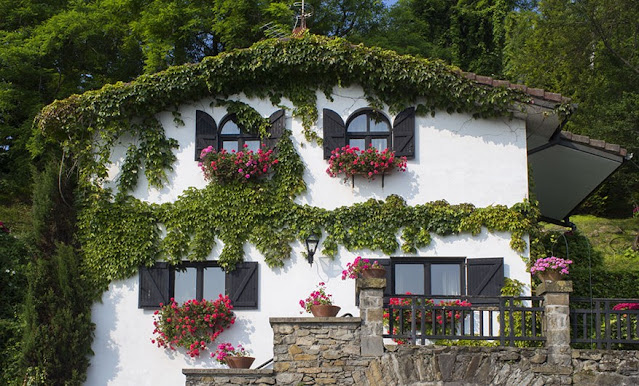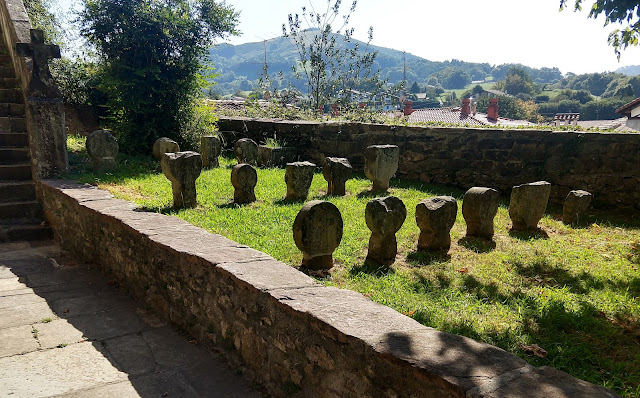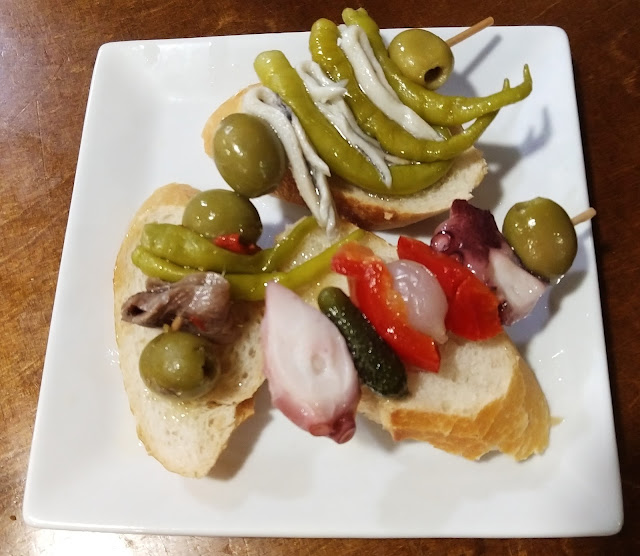 |
| Town Hall of Bera from 1776, refurbished in 1983 Quite ornate and imposing for such a small town of around 3,800 people |
This very small municipality is dotted with legends and poetry and also endured somewhat of a dark history. From its beginnings it has been a border town and for centuries, served as a defense of the Kingdom of Navarre against the French and the Basque. In 1402, Charles III the Noble recognized its work by granting it privileges, but sadly it also encouraged smuggling in the area.
From the title of this post, you probably don't know who or what I am talking about so read on to find out more.
The Town Hall is quite unique and the most notable
civil element in Bera. It is a Baroque
building from 1776 adorned with polychrome murals created by historian and anthropologist,
linguist Julio Caro Baroja (more on him below).
In 1983, during the refurbishment of its façade, remains of ancient mural paintings were discovered. These represent the four cardinal virtues (prudence, justice, fortitude, and temperance). It was restored by the local painter Juantxo Larramendi.
 |
| Loving the lines of this abandoned home from 1915 Villa Elisa, Bera |
In 1606, in the church of Bera (or Vera), Lorenzo de
Hualde was appointed parish priest. He was one of the main collaborator of the Spanish
Inquisition when it came to generating the witchcraft paranoia that unleashed
the Trial of Logroño starting in 1609. He intervened so that many of its
inhabitants were accused of witchcraft. Although
the number of people executed was small in comparison to other persecutions in
Europe, it is considered the biggest single event of its kind in terms of the
number of people investigated: by the end of the phenomena, some 7,000 cases
had been examined by the Inquisition although only six were ultimately executed. As was typical of witch trials, those accused
of witchcraft were predominantly women, however this tribunal also targeted
children and men, including priests allegedly guilty of healing with nóminas, which
are amulets bearing the names of saints.
Navarre was considered the land of sorcerers and persecuted heretics.
Side note: The Basque witch trials were featured
as a subplot in season four of the HBO series True Blood, when the spirit of
powerful witch Antonia Gavilán being fed upon, tortured, and condemned to death
by vampire priests in the city of Logroño in 1610, takes possession of a
modern-day Wiccan in order to exact revenge on vampires.
During the summer of 1794, Bera de Bidasoa was
occupied by French troops. As usual, the French carried out all kinds of
plunder. It also suffered destruction during the War of Independence and the various
Carlist conflicts.
 |
| The Itzea (The House in Basque) Mansion |
In 1912, Pío Baroja, one of the most distinguished
writers in Spain, bought a farmhouse in the town of Bera, the Itzea (The House
in Basque) Mansion. Since then, the history of Bera has been linked to the
lineage of this famous writer. In addition to the author himself, figures such
as Carmen Baroja have been frequent visitors to its streets. She was an
anthropologist, writer and mother of the most renowned Spanish historian Julio
Caro Baroja (nephew of Pio Baroja). Also linked to the world of letters,
Ignacio Larramendi, a member of the Royal Academy of the Basque Language (aka Euskaltzaindia),
is a native of the place.
Besides its architectural value, this famous stately
mansion was converted into a family estate, housing a splendid library with
more than 30,000 volumes. Today, its office seems ready for the novelist's
return, his stamps, cards and pens, all there awaiting. As a living museum, you can see this home
except for the areas where the family still lives from time to time.
‘For my sister and I, Itzea is another
member of the family,
like another grandmother who welcomes us throughout our
lives.
Every time I have had a
time of anxiety, I have taken refuge in her.'
Pio Caro-Baroja
Among the most remarkable things to see in Bera de Bidasoa are its noble houses. They are governed by traditional local architecture. It is common to see facades with wooden beam frameworks and balconies decorated with flower pots. In addition, they also have porticoed ground floors or large gabled roofs.
 |
| High balcony, large gabled roof |
 |
| Another beautiful local home |
Famous Visitors
Jose Bonaparte, (nicknamed Pepe Botella – Joe Bottle, because of his alleged excessive drinking since he wasn’t liked in Spain – but proven later to be false), older brother of Napoleon and King of Spain slept here between 1808 and 1813 on his way to France after escaping from the Battle of Vitoria. Later the Duke of Wellington (considered the conqueror of Napoleon) would do the same.
The most well-known past of Bera de Bidasoa dates back
to the 15th century, when Charles III, King of Navarre, granted the
town a series of privileges for having defended itself tenaciously from its neighbors
in Gipuzkoa and La Labor.
 |
| Church of San Esteban. I've never seen such an unembellished church Only bricks and stones, Bera, Basque Country |
The Parish of St. Stephen (Iglesia de San Esteban), named
after the first martyr of the Christian church (protomartyr) is a stunning
example of Spanish Renaissance religious architecture. The last fire which damaged the church occurred
in 1833 therefore, the current neoclassical hand-carved altarpiece covered in
goldleaf dates from the mid-19th century. However, the true jewel of the church is its
organ, considered the best romantic organ in Navarre and one of the best in its
style in Europe, made in 1895 by an organ builder from Azpeitia, Aquilino
Amezua.
Next to the entrance to the church of San Esteban de
Bera de Bidasoa, and at the foot of the stairs of its bell tower, you can find
a curious garden decorated with an ethnographic treasure. These are the
funerary steles, which belonged to the old cemetery that surrounded the church.
The discoid steles of Bera de Bidasoa.
All the discoid steles found in the church garden are
carved in red sandstone, except for one carved in granite. The drawings
engraved on the steles are very eroded, since they were used as paving for the
church floor, although on some steles you can still distinguish Maltese
crosses, Latin crosses, etc.
During the Napoleonic Wars the church’s bell tower was used as a prison, and the soldiers killed during the battle of the San Miguel de Bera bridge (see below) were buried at its feet.
 |
| Discoid steles in the side courtyard of the church |
 |
| Inaugurated in 1896 - beautiful organ |
 |
| San Miguel de Bera Bridge |
San Miguel de
Bera Bridge
This majestic bridge, dating back to the 13th
century, spans over the gentle flowing Bidasoa River and has a bit of
history.
On September 1, 1813, it was the scene of a tough
armed confrontation, the last throes of the War of Independence. The French had
been defeated in the battle of Vitoria and the intruding king, Jose Bonaparte,
had fled to France. But Napoleon tried to turn around the sad situation of his
troops in Spain.
The Napoleonic troops tried to loosen the siege of San
Sebastian. But they were defeated in the battle of San Marcial. Now they are
running like crazy with the Spanish and English troops hot on their heels, with
French general Vandermaesen, leading his troops in retreat. Night falls and the
weather is terrible. The torrential rain is crushing the morale of the soldiers
who, to make matters worse, find themselves facing a swollen Bidasoa River that
they can no longer cross by natural fords. The river has become a barrier that
could end up being a trap for the French. They have to find a bridge to cross
it.
British captain Daniel Cadoux, who, despite his surname
denoting French ancestry, has no special predilection for Bonaparte's troops, was
in charge of controlling and monitoring the passage of the Bidasoa over the San
Miguel de Bera bridge. To do this he had a hundred men from the 95th
rifle company and a few countrymen.
On one side of the bridge we have a strong French
contingent fleeing. On the other side of the bridge there are just over a
hundred men led by a rather stubborn and disciplined Cadoux ready to make
things difficult for the French. And as a backdrop, a night of infernal rain
and thunder that at times masked the sound of the shots.
The thousands of Frenchmen must have been surprised by
the presence of the defenders of the bridge. But even more so by the brutality
with which they fired volley after volley at them. The brutal disproportion of
forces was offset by the narrowness of the bridge and the swollen river, which
made it impossible to swim across it.
General Vandermaesen, desperate, led one of the
attempts to cross the bridge. He did not achieve his objective. A well-aimed
shot finished off the French general, increasing the confusion of the
Napoleonic forces.
Then dawn eliminated one of the most important
advantages for Cadoux's men, obscurity. The darkness of the night had meant
that the French did not know what they were facing. The retreating French army crossed
the bridge with the light of dawn.
Seeing themselves overwhelmed, the defenders had to
abandon the bridge, but Captain Cadoux, who was covering the retreat, was hit
and there he gave his life along with half of his men.
Cadoux defended the San Miguel bridge until his last
breath. The result of the War of Independence would have changed little if
Cadoux had retreated, since the Napoleonic troops already had their days
numbered in Spain. The easiest thing for the brave captain would have been to
flee. But it is admirable and surprising to see one give his own life in the
line of duty.
Courage, even irrational courage, is a rare virtue
that surprises the materialistic mind of the man of the 21st century.
If Cadoux had fled in the face of such a disproportion of forces, he would
surely have lived a few more years and soon forgotten. On the other hand, the
British captain's mettle in the face of the unequal combat has made him, in
some way, live forever in memory.
A plaque, raised in the center of the San Miguel bridge, commemorates the English captain:
It’s quite amazing to think such a small bridge led to
so many deaths and that history can be found in just about any corner of the
Basque Country.
 |
| Baguette vending machine We are near the French border, can you tell? |
Getaria has traditionally been a village of fishermen and great sailors such as Juan Sebastián Elcano (Elkano), the first man to truly circumnavigate the world. Juan Sebastián Elcano, a sailor and explorer, was born here. Elcano shares the title with Magellan as becoming one of the first persons to circumnavigate the globe by boat.
He sailed alongside the famous Portuguese
expeditionist but Magellan was killed in 1521 at a stop in the Philippines, so
he did not get to complete the entire journey. Elcano continued on one of the fleet’s
boats to fully complete the circumnavigation. He arrived back in Spain,
reaching Sanlúcar de Barrameda on September 6th, 1522, along with 17
crewmembers, after going around the world for three years.
Getaria was first founded by the Romans to hunt whales. For hundreds of years whaling was of great importance to the town’s economy. In fact, the whale has historically been the main motif for its coat-of-arms.
 |
| Same San Antón Park (nearly an island) in background Green vineyards in foreground |
 |
| Went by Getaria fishing village on way to Bera Sculpture of folks with nets on side of road up to Mount San Antón |
 |
| Not sure why this fishing boat has so many locks on rings |
 |
| Bringing fishing net in from dock to back of boat via long green tube |
 |
| Many restaurants have outdoor grills on the side of the streets Known for their mouth-watering turbot and anchovies |
Up a hill in Getaria, you will find a monument
honoring Juan Sebastián Elkano, appointed illustrious son of the town. The
sculpture displays elements of the Art Deco style, which was in vogue during
the period in which it was built. It sits on an old bastion of the wall of Getaria,
serving as its base. The monument is crowned with a Winged Victory of
Samothrace, in the style of the figureheads which adorned the prow of vessels
(originally from 190 BCE).
At the end of the port is where the Mount San Antón starts, which until the 15th century was just an island. Its shape is similar to a mouse and, for that reason, it is commonly referred to by the locals as the Ratón de Getaria (mouse of Getaria). The Mount San Antón is a natural park with a large variety of vegetation and animals (especially seagulls).
 |
| Winged Victory of Samothrace on top of Elkano's Monument |
 |
| Hard to see but green statue is of Juan Sebastián Elkano In front of his family home |
 |
| Serrano ham, goat cheese, pate, balsamic glaze At Itxaspe Taberna |
 |
| Very small pharmacy in town |




No comments:
Post a Comment
We are always happy to hear from you but at times it may take a while to get a reply - all depends if we have access to the internet.